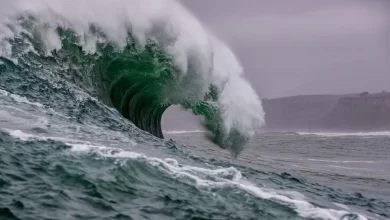Ice is the frozen, solid form of water. In cold weather, ice often forms on lakes, rivers, and the ocean. It can be extremely thick or extremely thin. Because of the expanded molecules, ice is much lighter than liquid water, which is why it floats.
- Ice is the frozen form of water. Ice often forms on lakes, rivers, and the ocean in cold weather. It can be very thick or very thin. It occurs as frost, snow, sleet, and hail.
- There are 17 recognized solid crystalline phases of water that can form all different kinds of ice. Of these, only two occur naturally on Earth, hexagonal ice and cubic ice.
- Ice is a pure substance; a pure substance is one that does not have any other substance or impurity present in it and cannot be separated into other kinds of matter by physical processes. Some other pure substances are Iron, Hydrochloric acid, calcium oxide, and mercury.
- We will not see liquid water and solid water together in a homogeneous mixture. That means your glass of ice water, with ice cubes floating in it, is a heterogeneous mixture of homogeneous mixtures.
- Ice on lakes is generally four types: primary, secondary, superimposed, and agglomerate. Primary ice forms first. Secondary ice forms below the primary ice in a direction parallel to the direction of the heat flow.
- Ice is less dense than water because the orientation of hydrogen bonds causes molecules to push farther apart, which lowers the density. Because ice is less dense than water, it is able to float at the surface of the water.
- The beginning of any form of ice crystal requires 275 molecules of water. However, a fully formed crystal contains about 475 molecules.
- Ice cores are cylinders of ice that scientists have drilled from the polar ice sheets. They give us information about Earth’s climate over the last 740,000 years.
- Under a microscope, one can see the shapes of ice crystals that comprise a snowflake. Some snowflakes are made of a single ice crystal, while other, more elaborate snowflakes are made of as many as 200 ice crystals fused together.
- According to the Snowball Earth theory, our planet was twice covered entirely with ice between 700 million and 600 million years ago.
- Presently 10 percent of the land area on Earth is covered with glacial ice, including glaciers, ice caps, and the ice sheets of Greenland and Antarctica. Glacierized areas cover over 15 million square kilometers (5.8 million square miles). Glaciers store about 69 percent of the world’s freshwater.
- The Antarctic ice sheet is the largest block of ice on Earth. It covers more than 14 million square kilometers (5.4 million square miles) and contains about 30 million cubic kilometers (7.2 million cubic miles) of water. The Antarctic ice sheet is about 2 kilometers (1.2 miles) thick.
- Ice Is Found Throughout Our Solar System beyond the asteroid belt, ices condensed in the colder reaches of space, forming the cores of Jupiter, Saturn, Uranus, and Neptune — the gas giants — and their moons.
- There are more than five million cubic miles of ice on Earth, and some scientists say it would take more than 5,000 years to melt it all. If we continue adding carbon to the atmosphere, we’ll very likely create an ice-free planet, with an average temperature of perhaps 80 degrees Fahrenheit instead of the current 58.
- There have been at least five major ice ages in the Earth’s history.
References
- Wikipedia-Ice
- Britannica-Ice
- Sciencealert.com(different types of ice)
- Gizmodo.com(molecules ice hold)
- Scied.ucar.edu(ice crystals that comprise snow flakes)
- National Geographic(Rising seas ice melt)





